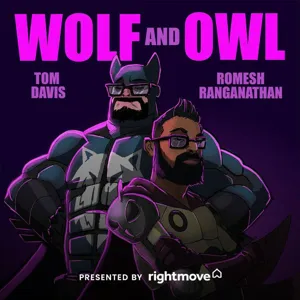Podcast Summary
Discovering connections between ancient sites and the night sky: Shopping at Kroger offers everyday experiences and opportunities for savings through digital coupons and fuel rewards, while also inspiring connections between everyday life and the natural world
Shopping at Kroger offers not only a vast selection of delicious meal options with everyday low prices, but also opportunities for extra savings and inspirational experiences. For instance, photographer Babak Tafreshi, who discovered his passion for astronomy as a teenager, found profound connections between ancient sites and the night sky. His life-changing encounter with the moon through a telescope mirrored the rising of the constellation Leo during the Persian celebration of Nowruz, which took place at the ancient site of Persepolis. This astronomical event was depicted in bas-reliefs at the site, revealing a deep connection between the ancient world and the night sky. Similarly, shopping at Kroger provides everyday experiences that can excite and inspire, while also offering opportunities for additional savings through digital coupons and fuel rewards.
The connection between our passions and heritage: Sharing passions and traditions can deepen our experiences and bring us closer to loved ones.
The connection between our passions and our heritage can deeply enrich our experiences and bring us closer to our loved ones. This was exemplified in the story of Babak Tafreshi, a photojournalist whose passion for astronomy led him to share the wonders of the night sky with the world, and in the celebration of Nowruz, a holiday rooted in ancient Persian traditions that brings families and communities together. The poem "Song of Spring" by Hafez encapsulates the renewal and rebirth that comes with the arrival of spring and the new year. For Babak and others, the traditions surrounding Nowruz, such as the Hafseen table with its seven symbols of spring, serve as a reminder of the past while also connecting them to the present and future. As Andi Mitchell and Sabrina Colberg, co-hosts of the Pop Culture Moms podcast, shared, the fictional moms we love to watch on TV and movies can also teach us valuable lessons about motherhood, family, and the importance of holding on to our traditions.
Nowruz: A Spring Holiday Connecting People and Symbols: Nowruz is a secular Persian holiday celebrating spring, bringing people together with diverse symbols, including religious texts and secular poetry. Its astronomical significance and enduring appeal make it unique.
The Nowruz tradition, a secular Persian holiday celebrating the start of spring, brings people together regardless of their religious or cultural backgrounds. The table, or "Haft Sin," which is a central part of the celebration, can include diverse symbols, from religious texts like the Quran to secular ones like Hafez's poetry. The connection between Nowruz and poetry, particularly Persian poetry, runs deep, with figures like Hafez and Omar Khayyam being celebrated for their poetic and scientific contributions. The holiday's astronomical significance is also noteworthy, as ancient civilizations relied on astronomers to create accurate calendars, which were essential for both religious and practical reasons. Nowruz's universal appeal and its connection to a specific moment in time make it a unique and enduring tradition.
Appreciating the connection between the natural world and the night sky: The night sky and its constellations have inspired human connection and appreciation for nature and our place in the universe throughout history
The night sky has been a source of fascination and connection for civilizations throughout history, including our ancestors a thousand years ago. By looking up at the stars, we can find common ground with the past and gain a deeper appreciation for our place in the universe. For example, during the spring equinox in the Northern Hemisphere, the constellation Leo, with its reverse question mark-shaped head and bright heart star, symbolizes the arrival of spring. This connection between the natural world and the night sky has inspired artists, poets, and explorers throughout history, including photographer Babak Tafreshi, who has dedicated his work to capturing the beauty of ancient sites beneath the stars. Through his photography, Babak emphasizes the unity of earth and sky, and encourages us to appreciate the transient nature of human civilization in contrast to the eternal beauty of the cosmos.
Reconnecting with the Night Sky: Explore the night sky's beauty through photography, connect with the universe, and overcome light pollution to regain a sense of wonder and awe.
Reconnecting with the night sky is a profoundly human experience that can help bridge the disconnection many people feel due to light pollution. Babak's project, The World at Night, showcases the beauty of the night sky through the images of dedicated nightscape photographers. These photographs transport viewers to a place where they feel connected to both Earth and the universe. Unfortunately, more than two-thirds of the human population live in areas affected by major light pollution, preventing them from experiencing the night sky in its full glory. To resolve this disconnection, it's essential to send people to places with darker skies and encourage them to reconnect with the darkness and the stars that emerge from it. Nighttime photography is a life-changing experience that allows photographers to connect with the stars and discover the celestial sphere above them. While it can be technically challenging, with the right equipment and planning, anyone can try it at home using smartphone applications to help identify constellations and plan their shots. Overall, reconnecting with the night sky is an essential experience that can bring a unique sense of connection to the natural world.
Exploring the night sky through various means deepens our connection to the universe: Exploring the night sky through apps, photography, ancient sites, science, archaeology, and art inspires wonder and curiosity about the world beyond our reach, bridging the gap between everyday life and complex concepts.
Exploring the night sky through planetarium apps, photography, and ancient sites can bring us a deeper connection to the universe and inspire a sense of wonder and curiosity about the world beyond our reach. The night sky, represented by the iconic Mount Damavand in Iran, serves as a reminder of our roots and our place in the universe. Science, archaeology, astronomy, and photography can help bridge the gap between everyday life and complex scientific concepts, making them more accessible and inspiring to the general public. The connection between art and science can serve as a powerful bridge, as seen in Babak's photograph of the star trails above the ancient ruins of Persepolis. Through these experiences, we can be transported back in time and appreciate the awe-inspiring beauty of the night sky, just as ancient astronomers and poets like Omar Khayyam did.
Celebrating Nowruz: A Time for Reflection and Connection: Nowruz, the ancient Persian new year celebration, encourages us to reconnect with our cultural heritage, appreciate the natural world, and deepen our connection to it through unique experiences and sounds.
The ancient practice of celebrating the new year during Nowruz not only connects us to our cultural heritage and the natural world, but also encourages us to appreciate the beauty and transience of life. This was exemplified by the speaker's personal experiences of visiting Mount Damavand and celebrating the Persian new year with his family. Furthermore, the introduction of the new segment "SoundBank" on Overheard offers listeners a unique way to immerse themselves in the audible Earth, revealing the wonders of our world through the sounds of National Geographic explorers and photographers. By tuning in to Soundbank, we can broaden our understanding of the natural world and deepen our connection to it. Additionally, the speaker encouraged listeners to learn more about Iran's rich poetic tradition and the efforts of organizations like the International Dark Sky Association to protect the night sky from light pollution. Overall, Nowruz serves as a reminder to reconnect with the past, appreciate the present, and look forward to the future.
Exploring the Effectiveness of Half Scene Tables: Half scene tables can help visualize and organize complex information, with inspiring examples provided in a podcast episode featuring a team of dedicated professionals.
Creating a half scene table can be an effective tool for visualizing and organizing complex information. This method was discussed in detail during the podcast episode, featuring inspiring examples for those looking to create their own. The production of this podcast involved a team of dedicated individuals, including producers, editors, fact checkers, sound designers, and composers. The podcast is a production of National Geographic Partners, with Whitney Johnson as the director of visuals and immersive experiences and David Brinley as the interim editor in chief. I'm Dawah Ardelon, the executive director of audio, and I encourage you to check out the show notes in your podcast app for more resources related to this topic.






